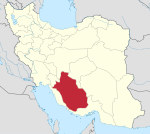Buraki Rural District
Appearance
Boorekey Rural District
Persian: دهستان بورکی | |
|---|---|
| Coordinates: 29°32′16″N 51°19′49″E / 29.53778°N 51.33028°E[1] | |
| Country | Iran |
| Province | Fars |
| County | Kazeroun |
| District | Khesht |
| Capital | Boorekey-ye Olya |
| Population (2016)[2] | |
• Total | 3,685 |
| Time zone | UTC+3:30 (IRST) |
Boorekey Rural District (Persian: دهستان بورکی) is in Khesht District of Kazeroun County, Fars province, Iran. Its capital is the village of Buraki-ye Olya.[3]
History
[edit]After the 2006 National Census, the city of Khesht and other parts were separated from Khesht and Kamaraj District[a] in the establishment of Khesht District. Boorekey Rural District was created in the new district.[3]
Demographics
[edit]Population
[edit]At the time of the 2011 census, the rural district's population was 3,368 in 942 households.[4] The 2016 census measured the population of the rural district as 3,685 in 1,124 households. The most populous of its 21 villages was Boorekey-ye Olya, with 2,414 people.[2]
See also
[edit]Notes
[edit]References
[edit]- ^ OpenStreetMap contributors (5 October 2024). "Buraki Rural District (Kazerun County)" (Map). OpenStreetMap (in Persian). Retrieved 5 October 2024.
- ^ a b Census of the Islamic Republic of Iran, 1395 (2016): Fars Province. amar.org.ir (Report) (in Persian). The Statistical Center of Iran. Archived from the original (Excel) on 6 April 2022. Retrieved 19 December 2022.
- ^ a b c Davodi, Parviz (c. 2023) [Approved 9 October 1387]. Letter of approval regarding the changes and reforms of divisions in Fars province. qavanin.ir (Report) (in Persian). Ministry of the Interior, Political and Defense Commission. Proposal 42/4/1/41746. Archived from the original on 21 September 2023. Retrieved 21 September 2023 – via Laws and Regulations Portal of the Islamic Republic of Iran.
- ^ Census of the Islamic Republic of Iran, 1390 (2011): Fars Province. irandataportal.syr.edu (Report) (in Persian). The Statistical Center of Iran. Archived from the original (Excel) on 16 January 2023. Retrieved 19 December 2022 – via Iran Data Portal, Syracuse University.


